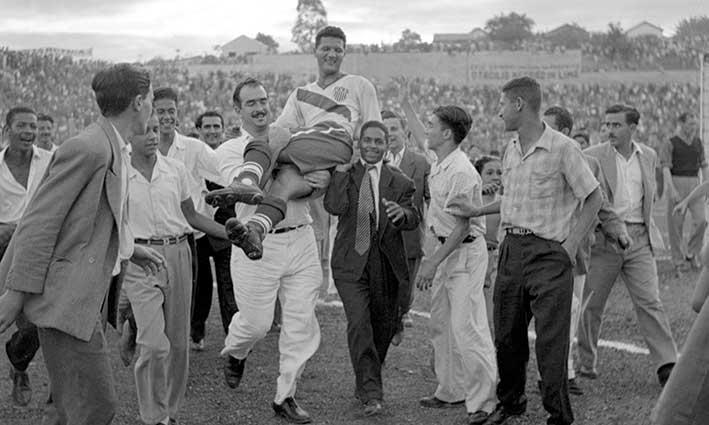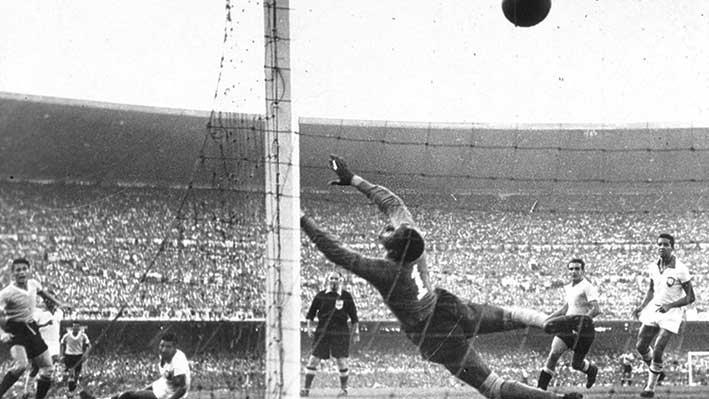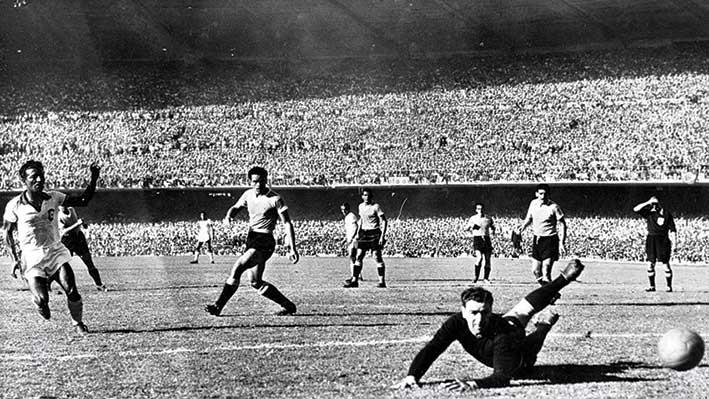After the war, FIFA were keen to resurrect the competition as soon as possible, and they began making plans for a World Cup tournament to take place. In the aftermath of the war, much of Europe lay in ruins.
As a result, FIFA had some difficulties finding a country interested in hosting the event, since many governments believed that their scarce resources ought to be devoted to more urgent priorities than a sporting celebration.
The World Cup was at risk of not being held for sheer lack of interest from the international community, until Brazil presented a bid at the 1946 FIFA Congress, offering to host the event on condition that the tournament take place in 1950.

USA hero Joe Gaetjens is raised aloft in Belo Horizante in 1950. Photo: FIFA
Brazil's determination to put on a show meant they built the world's biggest football stadium, the Maracana, yet their dream of becoming the world's best died in that huge bowl, Uruguay capturing their second crown by beating the hosts in front of some 200,000 stunned spectators.
Italy was of particular interest as the long-standing defending champions, having won the two previous tournaments in 1934 and 1938; however, Italy's national team was weakened severely as most of its starting line-up perished in the Superga air disaster one year before the start of the tournament.
The Italians were eventually persuaded to attend but travelled by boat rather than by plane.

Uruguay’s Ghiggia scores the winning goal past the dive of Brazilian goakeeper Barbosa to win the World Cup for Uruguay. Photo: FIFA
The British nations were invited to take part, having rejoined FIFA four years earlier, after 17 years of self-imposed exile. It was decided to use the 1949–50 British Home Championship as a qualifying group, with the top two teams qualifying. England finished first and Scotland second.
But England were eliminated by the United States who defeated the Masters of football in one of the greatest upsets in history.
Both Germany (still occupied and partitioned) and Japan (still occupied) were not permitted to participate in qualification. The French-occupied Saarland had been accepted by FIFA two weeks before the World Cup, several months before the German Football Association (DFB) was reinstated, while Soviet-occupied East Germany had not yet founded a football association.

Uruguayan goalkeeper Maspoli dives to try to reach a Brazilian shot during the final group match at the 1950 FIFA World Cup. The shot goes wide. Photo: FIFA
This was the only tournament not decided by a one-match final, with four nations, Brazil, Uruguay, Sweden and Spain playing in this final group. Brazil trounced Sweden 7-1 and Spain 6-1, whilst Uruguay struggled against the Scandinavians 3-2, and were held by Spain 2-2.
Brazil needed only a draw against Uruguay and even took the lead through Friaca, but Schiaffino and Ghiggia gave Uruguay a stunning victory to silence the 200 thousand and send a whole nation in mourning.
La Celeste thus secured their second title to lift the trophy now called Jules Rimet Cup to mark the 25th anniversary of Jules Rimet's presidency of FIFA.